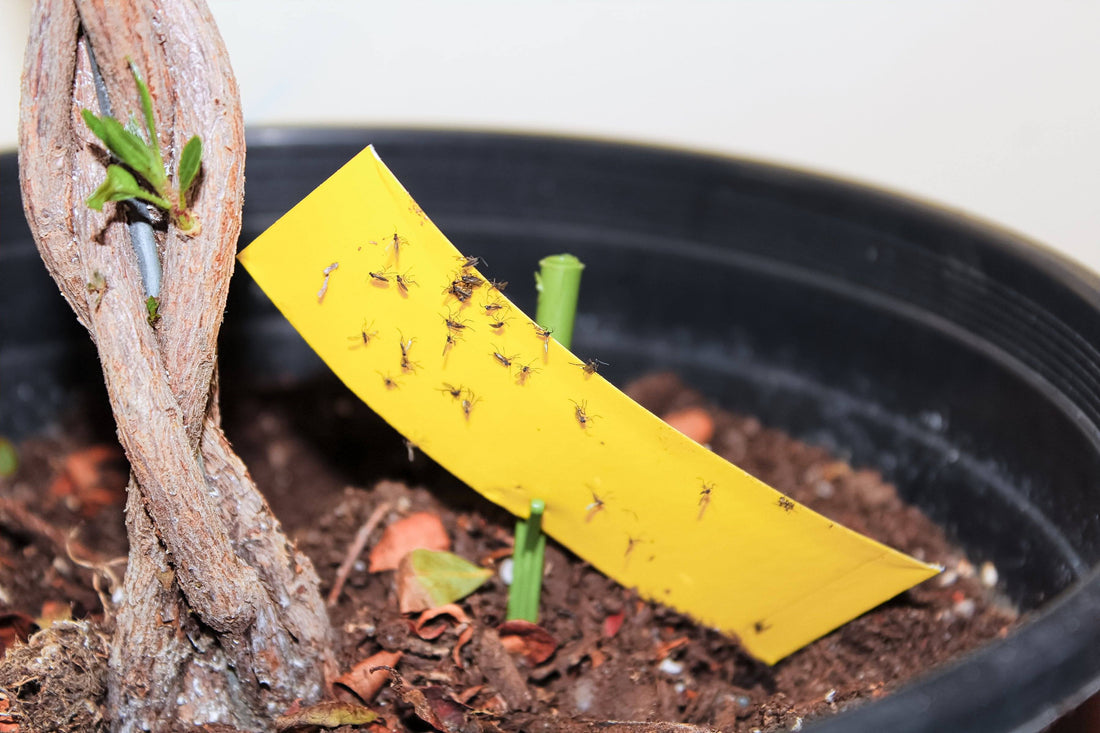Let's talk about the most common (and arguably most annoying) houseplant pest: the fungus gnat. These grey-winged creatures have slender, black bodies and are commonly mistaken for fruit flies; only instead of eating your fruit, they're in your soil eating fungus.
Fungus gnats don't always harm plants, but they can accidentally munch on plant roots in search of fungus. Even if they don't harm our plants, they multiply quickly and no one wants hundreds of tiny flies in their green zen-zone. In case you're wondering what they look like, here's a close-up.

If you want to see what they look like IRL, click here. Sometimes, infestations get really bad, and you'll have to get rid of larvae in the soil, too. They look like this. 🤢
Treatment
You'll probably notice them immediately when you add water to your soil. They don't want to drown, so they all buzz to the surface and fly around your plants and/or face. It's incredibly annoying. They must be stopped!! Here's how:
- Use sticky traps. These nifty Super Sticky Gnat Traps will attract and capture gnats for you. If the infestation is minor, this can be enough to take care of the issue within a week or so.
- Let your soil dry. Fungus grow in moist conditions and, once they do, they'll find a way into your plant's home. So, if you notice your soil staying wet for over a week, move it to brighter, dryer conditions for a bit.
- Drown them out. In our experience, the easiest way to do this is to use equal parts 3% hydrogen peroxide and water. This will kill larvae and eggs in the soil, as well as adults that get trapped in the wet soil. This solution is gentle on the roots, so it won't harm your plants. Only do this when the plant is ready for a watering—otherwise you're putting it at risk for root rot.
- Add diatomaceous earth. This stuff is the definition of "death by a thousand cuts." When a layer of this is applied to the top of your soil, it will literally cut up the bodies of the gnats trying to surface, killing them on impact!! Pretty nuts. Grab some here. *This is a food grade product and is totally harmless to pets and humans of all ages.*
- Grab some sticky traps. Adding sticky fly traps in and around your pot will do the trick to catch any stragglers.
- Monitor daily. Inspect your plant frequently for any sign of survivors. It may take a couple of treatments before they're gone for good, but with vigilance, they will be defeated. 💪
Now that you've won the battle and all is quiet, make sure your plant is in good spirits. Keep it in its preferred light position and water it as usual. You can ditch the hydrogen peroxide now. If it's been 6 weeks since it was last repotted, give it some plant food. It'll appreciate a nutrient boost after all that.
Prevention
Now that you've experienced a feud with fungus gnats, you're likely wondering how to stop it from ever happening again. Here's what you can do:
- Inspect your plants. Anytime you get a new plant, it's wise to give it (and the soil) a thorough inspection and a quick wash in the sink. Most shops and nurseries are vigilant about pest control, but it's nature and it happens.
- Add a preventative. Natural fungicides are easily accessible, and you probably already have them in your kitchen cabinet. Add a thin layer of ground cinnamon or water occasionally with cooled chamomile tea. These are simple and great ways to keep fungus (and gnats) at bay.
- Use sticky traps. If you don't have a current gnat infestation, Super Sticky Gnat Traps can help you keep it that way. Placing them in your pots will prevent gnats from ever making it into the soil.
- Use pesticides. Neem oil is a naturally-occurring pesticide that you can safely spray on your plants to prevent pest outbreaks. It also has anti-bacterial and anti-fungal properties and, if diluted properly, you can water with it, too!
If you're ever uncertain if you have a pest problem on your hands, you can always email us at hello@heyrooted.com

